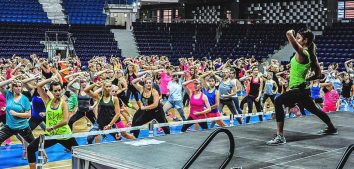
Physical activity during pregnancy
I encourage all future mums to have an active lifestyle. While respecting the basic principle the risk for pregnancy is minimal, and the benefits for you and your child are enormous.
If you are healthy and your pregnancy is not compromised, and the doctor will give you a green light, you can continue your physical activity, which also prepares your body for childbirth.
Why?
- The average energy cost of birth: 2.3 kcal / min (walking 4-5 km / h)
- The average duration of labor is 7-10 hours
- Energy expenditure allows you to travel the distance of 40-50 km (marathon)
Many scientific studies have shown that systematic, moderate physical activity during uncomplicated pregnancy is completely safe and has a positive impact on not only the movement, but on the whole body, both your and the baby. In particular, the overall physical fitness, aerobic and strength, both during pregnancy and after birth. It is now recognized that some habits gained during pregnancy can positively affect the health of the life for the mum and the baby. Regular physical activity during pregnancy will help you improve or maintain overall fitness of the body, help to control weight, reduce the risk of gestational diabetes if you have a problem with overweight and obesity and, above all, improve your mood and give a decent power kick 🙂
- physical activity improves the functioning of the cardiovascular and respiratory systems, making it easier endure effort during pregnancy and the birth
- increases blood flow to the uterus and placenta which is a positive factor for fetal development and pregnancy
- improve metabolism and reduce your weight gain, you prevent obesity and quickly get back into shape after childbirth
- you have a greater chance of normal pregnancy in relation to pregnant non-exercisers
- among active women during pregnancy rarely occurs preterm delivery, transfer pregnancy, abnormal position of the fetus, obesity, and the formation of stretch marks
- shorter duration of individual periods of childbirth, faster progressing dilation of the cervix and less painful contractions
- length of hospital stay after the labout is shorter for active women, and the rate of maternal mortality is three times lower than in the general population of women in labor
- in the postpartum period, women who exercised during pregnancy more quickly regain physical and mental balance
- as a result of better blood circulation breast lactation among active women starts earlier and last longer compared with women who did not exercise
- physical exercise reduce anxiety before birth and ensure restful sleep
- you’ll feel less pain
- prevent constipation
- improve overall physical fitness and heart strenght
- streamlines your workflow cardiovascular and respiratory
- decrease the risk of complications during pregnancy, such as preeclampsia, gestational diabetes, as well as shorten the length of labor.
In addition to these advantages, further training has an excellent effect on the child:
Newborns whose mothers exercised during pregnancy achieve higher Apgar score compared to babies of women not practicing. We observed lower rates of morbidity and mortality of infants born to mothers who regularly exercising. During physical exercises of medium intensity, you will notice moderate increase of blood flow to the uterus and placenta which is a positive factor for fetal development and pregnancy.
DANGER FOR PHYSICAL ACTIVITY DURING PREGNANCY
You need to take special care while intense exercising during pregnancy, because the blood from the abdominal cavity of the uterus moves to the working muscles and skin (risk of fetal hypoxia). During the exercises you can have an increase in body temperature (hyperthermia). Presumably the increase in body temperature above 40 degrees can cause damage to the fetus. Too intense exercise can cause premature labor by stimulating contractions of the smooth muscle of the uterus. Pregnancy is the time when your body goes through a lot of changes and it is important to choose exercises that y take it into account and not only prevent the loss of physical fitness, but also allow it to increase. Suitable selected exercises have beneficial effects on the joints because the levels of hormones produced in pregnancy causes the joints to be more prone to injury due to loosening of the ligaments. Another change is the transfer of the center of gravity for the precinct of the pelvis and lower back. Because you are less stable and more vulnerable to loss of balance, the greater the risk of falling
Dont workout during pregnancy if you have symptoms such as:
- Bleeding
- Failure of cervix pressure
- Severe forms of gestosis pregnancy
- Hypertension
- Diabetes
- Anemia of high degree
- Pyelonephritis
- Multiple pregnancy (twins)
- Infections, colds, fever
- Earlier premature births
- Heart and lung disease
- Placenta previa after 26 weeks of pregnancy
- Preeclampsia
EXERCISES IN THE FIRST TRIMESTER OF PREGNANCY
In the days in which menstruation would be due, if you were not pregnant, you need to reduce your exercise or withdraw from them, due to the possibility of miscarriage.
If you were active before pregnancy its great! Continue your lifestyle, but replace exercise for less intense ones. A peaceful walk not to exceed 140 beats per minute have the best effect on your body. If you previously didnt work out, ask your doctor! It is recommended that a woman should train for 30 minutes three times a week.
Exercises in the first trimester of pregnancy should not put too much strength on you and cause increased tension of the abdomen – this could contribute to miscarriage. It is recommended to exercise with low intensity and to do breathing exercises, and correcting poor posture, as well as exercise your arms and legs in a wide range. They should be performed from the beginning of pregnancy, because the correct posture reduces the load on the spine.
EXERCISES IN THE SECOND TRIMESTER OF PREGNANCY
In the second trimester repeat the same exercises. Add exercises that will strengthen the pelvic muscles – eg. “March” on the buttocks forward and backward, and – improving the flexibility and mobility of the hip joints, for example. Circulation of legs. You should also activate the breathing exercises that will be needed in the first and second stage of labor.
Avoid:
exercises with jumping and rapid movements
exercise in a position lying on you belly
exercises in lying on your back
exercises involving abdominal muscles, particularly the rectus abdominis muscle, eg. lifting both legs
skating, ice skating, skiing
biking over rough terrain
diving, mountain climbing, because in the course of these activities can lead to hypoxia
Regular exercise during pregnancy have beneficial effect on your health, improve posture and relieve back pain and fatigue. There is evidence that exercise during pregnancy may protect women before the onset of gestational diabetes and reduce stress.
EXERCISES IN THE THIRD TRIMESTER OF PREGNANCY
In the third trimester you should repeat the exercises of the first two trimesters, but above all, emphasis on breathing exercises. Proper breathing during labor will allow you to relieve muscle tension and improve uterine blood flow to the baby. Also use relaxation exercises involving the tensing and loosening the muscles of each part of the body , then tensioning and loosening the larger muscle groups simultaneously. It is also important that you practice in the most appropriate position relaxed. Exercise the muscles of each part of the body (circulation wrists, flexing the fingers and toes), improves blood circulation, prevents the formation of swelling and varicose veins. Exercise for arms and forearms of both hands will strengthen the pectoral muscles and improve breast shape.
KEY PRINCIPLES OF EXERCISING
- Exercises performed only with the consent from your doctor
- During a workout, drink a lot of water
- Do not begin training in your first trimester
- Do not raise your hands above the shoulders
- Dont do deep squats
- Exercises that require you to touch your toes are not recommended
- Do not perform exercises to strengthen the abdominal muscles
- Do not perform the exercises, lying on your back
- I recommend exercising while sitting down on the ball, lying sideways in the supported kneeling, on the support side
- In the advanced stage of pregnancy, avoid exercises in a standing position
- Do not use the weights in the third trimester
- Stop exercising if you feel lower abdominal pain, headache, you have shortness of breath, or its hard to keep talking










Comments No Comments
Join the discussion…